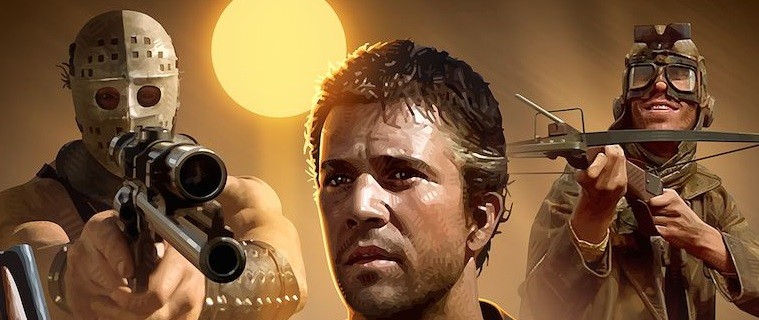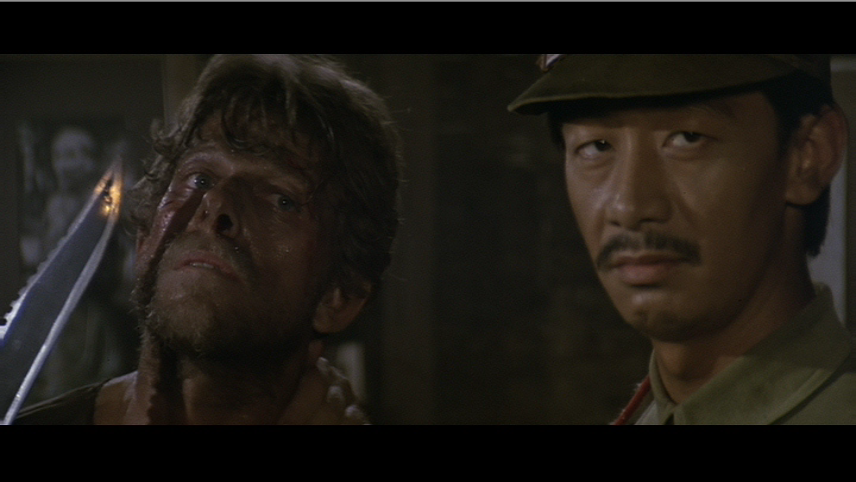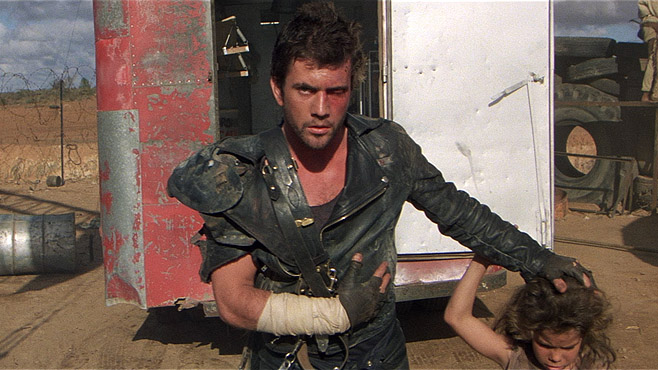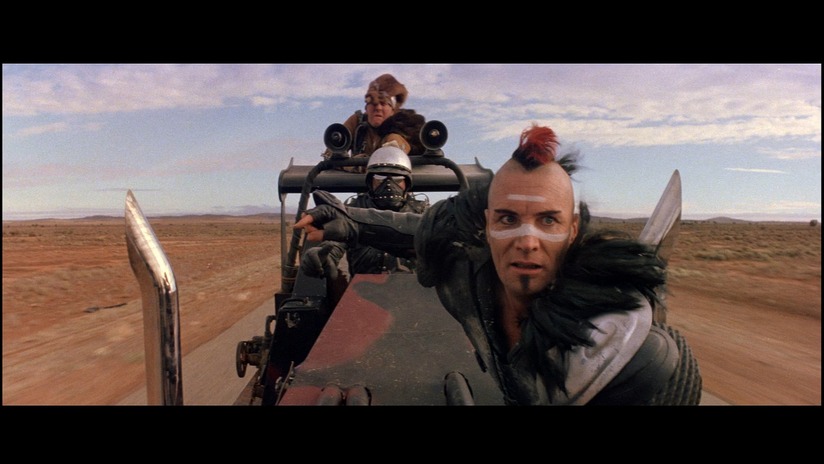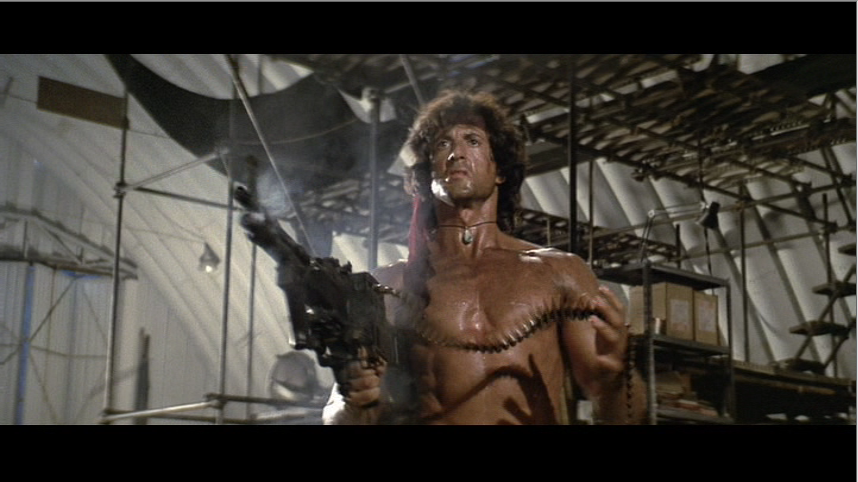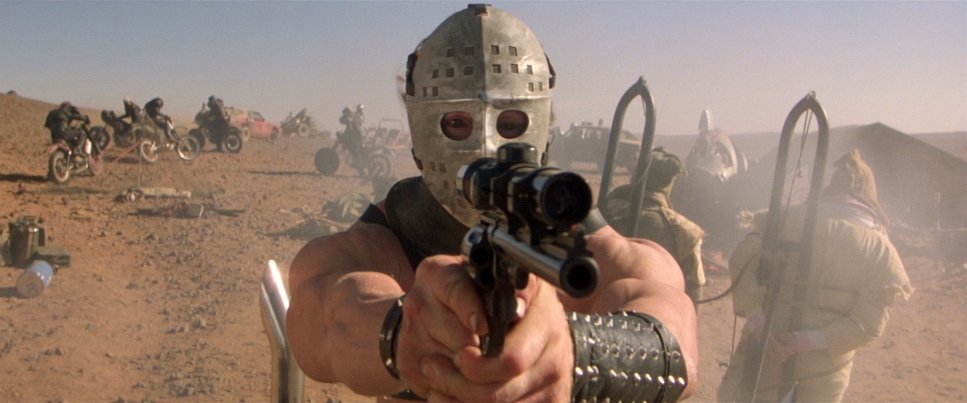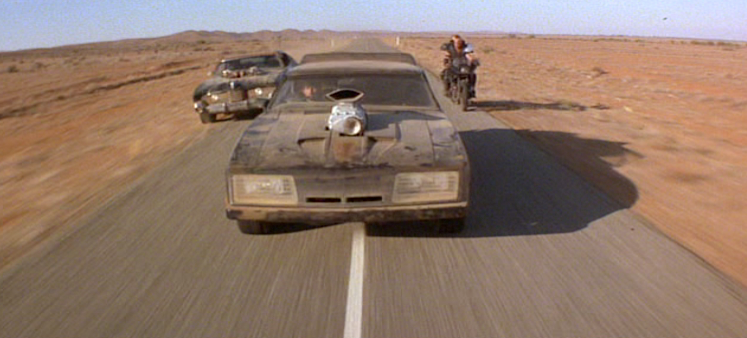Written By Zak Attack
Now this is where the action franchises really go off the rails in the best way possible. Last time we discussed the original more grounded genre conventions of both Mad Max and First Blood, but with these first (creatively titled) sequels it’s time to go all-in and blow some stuff up. Our heroes have accepted that they’re no longer made for their respective worlds and instead are the best they are at what they do… and what they do isn’t very nice.
The Tale of the Tape:
The Summary:
In an opening narration, The Road Warrior (aka, Mad Max 2) explains that due to an unnamed war, oil is scarce. The previous film definitely took place after some sort of fuel crisis as well, but the state of things have deteriorated considerably. In Mad Max, Rockatansky still lived in a suburban house. In The Road Warrior, permanent residence seems to be an illusion with all the marauding bikers and gangs wearing beat-up football pads.
Max starts up an uneasy alliance with an untrustworthy gyro captain (credited as “Gyro Captain”) who tells him of a ramshackle settlement built around an oil well. Frankly, they’re flush with the stuff. Max cajoles his way in and reluctantly helps them against the attacking “Lord Humungus”, the Jason Voorhees-lookin’ big bad of a leather-bound gang of murders and rapists.
Rambo: First Blood Part II opens in the military prison holding John Rambo after the events of the last movie. Col. Trautman arrives and tells him they need his expertise as a POW escapee for a reconnaissance mission involving some U.S. soldiers that are still being held by the Viet Cong. The man in charge of the mission is Marshall Murdock who, unbeknownst to Rambo, is an opportunistic bureaucrat who was planning on getting pictures of an empty prison camp for publicity. Unbeknownst to Murdock, there actually are POWs being held at the camp. When Rambo shows up to the drop zone with an emaciated prisoner in tow, Murdock leaves him there for dead.
Since this is 1985, the Soviets show up and spark a viciously violent response from Rambo. He literally kills every Russian and Vietnamese person in sight and absconds with a group of POWs and a helicopter, only to go back to home base and beat the crap out of Murdock for willfully abandoning American soldiers in the hands of the enemy.
The Competition:
Category 1 – The People Who Get Paid to Talk:
When John Rambo first lands in Thailand he meets up with his contact Co Bao, who is supposed to help him get across the border into Vietnam. She is played by Double Dragon star Julia Nickson and is absolutely terrible. It’s not clear if this was an actor’s or filmmaker’s decision, but her broken English sans accent somehow makes it seem even more offensive than if they’d just hired Mickey Rooney to play the character. “It bring me good luck” and “What mean expendable?” are phrases which sound even more alien when coming out of a mouth that sounds purely American.
Despite being a huge drag in the last film, Richard Crenna’s schtick works much better in this highly preposterous sequel. Charles Napier is a fun, campy addition as Murdock and Steven Berkoff is appropriately cool and calculated as the menacing Soviet colonel who tortures John Rambo. Sylvester Stallone on the other hand, loses the more subtle emotional weight of his earlier role and goes for a broad action movie performance.
In The Road Warrior, the performances are perfectly pitched to the desolate, uncaring landscapes. Mel Gibson plays Max as a man of few words who is always observing his surroundings and evaluating the best next steps for his own survival. Despite being a rough and tumble character he’s beautifully identifiable… and not just because he’s the protagonist or because of his history of loss as seen in Mad Max. The audience sympathizes with him because every character is able to portray just the right amount of distrust. By giving us such little character background for everyone else we can’t help but agree with most of his life-or-death choices.
Even the more over-the-top characters like Bruce Spence’s “Gyro Captain” and Max Phipps as “The Toadie” are grounded enough that the manic energy they bring to their roles works in context.
SCORE: The Road Warrior: 1 – Rambo: First Blood Part II: 0
Category 2 – What they Get Paid to Say:
Famously, Mel Gibson only has 16 lines in The Road Warrior, despite being the main character. That may seem like a sign that he’s alone or aggressively unresponsive for most of the film, but he truly just doesn’t have that much to say. One of the brilliant touches in The Road Warrior is that it’s bereft of almost all exposition. When Max first shows up to the oil refinery settlement, he stakes out the place in order to work out a way to get at some of the gasoline. Through his binoculars from a far-off cliff we get to see the machinations of the small fortress and a group of villains led by Lord Humungus intent on violently separating the the “good guys” from their stockpile of gasoline.
A lesser movie would have a prolonged sequence where Max enters the compound and a character gives him a tour while explaining the conflict and background. “We built this a few years ago… this boy here is feral and comes and goes as he pleases… Humungus is intent on murdering us and taking our gas.” Instead, Max truly acts as the audience surrogate by merely sitting back and watching. George Miller uses the visual language of film to give us a strong sense of place. Then the bikers come and demand the gas. It’s at this moment where the hero offers his help. Setting, conflict, and the potential resolution are all naturally meted out to the audience as needed.
Rambo: First Blood Part II is an excessively stupid and fun movie. It’s not quite “so-bad-it’s-good”… it’s more “so-cliché-it’s-fun.” It would be easy to like it ironically, but sometimes the more intelligent thing to do is accept the movie for what it is: a rough framework on which to hang preposterous setpieces. Rambo and Co Bao don’t need chemistry for the audience to buy any type of emotional commitment for each other, because director George P. Cosmatos presupposes that such a heightened movie only needs the narrative beats to simply “exist” for the audience to go along for the ride. I’d argue that he’s correct.
More importantly, Cosmatos also really knows how to shoot a scene. The action is clear, crisp, and cacophonous. There are even some beautiful photographed shots of the jungle and (dare I say) delicately framed scenes. The second Rambo film works precisely because it transplants you to another world, no matter how silly that world might be.
Not to say one must love this movie in earnest. It’s exceptionally dated from its shoehorned Soviet characters to its anti-technology slant to its belief that xenophobia can still be fun. The Road Warrior, on the other hand, is near perfect on all levels of execution.
SCORE: The Road Warrior: 2– Rambo: First Blood Part II: 0
Category 3 – A Place in the Franchise: Genre Classification
The theory for comparing these two films is that both blew up the first movie’s concept (both literally and figuratively) into pure, straightforward action films. The Road Warrior imagines a world 10 steps farther into the promised dystopia, but this time with more blood, “boom”s, and bombast. Similar to The Walking Dead, this sequel is interested in seeing what happens when social norms are jettisoned for lawless anarchy. Just by virtue of this larger societal thesis, The Road Warrior is more thematically ambitious than Mad Max.
Rambo: First Blood Part II certainly takes a left turn from the original’s complicated musings on the treatment of Vietnam veterans on our own shores. It seems more concerned with espousing the “live prisoner” theory, that even as late as 1985 there were still Americans being held in POW camps in North Vietnam. In fact, in one of the more on-the-nose scenes, John Rambo explicitly looks into the camera and snarls, “You know there’s more men out there and you know where they are. Find them… or I’ll find you.” Later he shouts, “I want, what they want, and every other guy who came over here and spilled his guts and gave everything he had, wants! For our country to love us as much as we love it! That’s what I want!” Cue cheesy snooze-ballad “Peace in Our Life” by none other than Sly’s brother Frank.
Like everything else in Rambo: First Blood Part II the politics are a bit ham-fisted and stupid. Even more noticeable is the realization of how much bigger this movie is than its predecessor. Over the course of two movies, Max Rockatansky goes from hunting down a gang of ten homicidal hoodlums to thirty or so. John Rambo, on the other hand, goes from non-lethally fighting some small town law enforcement to decimating entire squadrons of Vietnamese and Soviet soldiers. It’s too ridiculous and wonderfully self-indulgent not to respect as a consistently exaggerated action film. This one’s a tie.
SCORE: The Road Warrior: 2 ½– Rambo: First Blood Part II: ½
Category 4 – Action A Go Go
Rambo: First Blood Part II is an orgiastic celebration of fireballs, bullets, and explosive bows and arrows. It’s a rollickin’ fun time when Rambo stealthily executes a few guards and rescues a single POW who is being tortured. It’s pretty nuts when he’s captured and immediately escapes in order to murder a bunch more bad guys. However after Co Bao is killed, the pandemonium reaches dizzying heights when he goes on a fiery rampage against a search party, two separate Viet Cong bases, and a giant helicopter. The true highlight is when the emaciated soldiers who have been tortured and imprisoned for the past 15 years start to man the M60s and mow people down.
The only real drawback is that there are almost too many motivations that drive Rambo to such absurd mayhem and they’re all wrapped up in a pretty bow over the last fifteen minutes. After avenging Co and rescuing the POWs in one fell swoop, he immediately flies over to the U.S. base and intimidates Murdock along with his evil computers.
The Road Warrior is a much simpler story. Both Humungus and Max want gas. Max wants to trade his services for enough fuel to live on for the near future. Humungus wants to straight-up take it for himself. They butt heads in their goals and fight. It’s a simple problem of a violent group attacking a more peaceful group for their resources.
What The Road Warrior does best is show a fast-moving, heavy vehicle get ripped apart like a piece of tin foil. The movie is all vroom/crash/screech/scratch/boom, and the 15-minute long chase involving the tanker at the end is fantastically well-paced. It was on this second viewing, in fact, that I realized how similar the truck heist/chase scenes in some of the Fast & Furious movies have been to this early outing. Practical effects, spectacular stunts, and kinetic yet easy-to-follow camerawork are paramount to shooting these thrilling action scenes with style. It’s a wonder to see exactly how similar the final chase is to those big budget car movies after taking into account the considerable limitations of this expertly edited Australian genre flick.
That being said, Rambo: First Blood Part II is simply too wild to discount here. Its sweaty focus on guns, death, and explosions make the action nearly pornographic. Even the dvd names the scenes things like “Explosions” and “Direct Hit”. On a pure visceral level, The Road Warrior (unfortunately) just barely loses this round.
SCORE: The Road Warrior: 2 ½– Rambo: First Blood Part II: 1 ½
Category 5 – A Character’s Journey
Mad Max is about a good person being slowly beaten down by a declining society. Its sequel is about a cautious man who has already been burned trying to do what he can to survive. Similar to Yojimbo (or more accurately, the western remake A Fistful of Dollars), Max Rockatansky self-servingly comes into town only to start to care about others (whether through emotional connection with the townsfolk, a need for revenge, or both) and reluctantly saves the day. Seeing the flickers of the Main Force Patrol officer he once was extends his character arc across two movies instead of having Rockatansky solely be an anti-hero.
And that continuity gets at my main beef with the second Rambo film. Being a dark tale of the ills of post-Vietnam America, the original First Blood‘s original ending involved John Rambo fittingly taking Trautman’s gun and killing himself with it. Test audiences apparently didn’t appreciate the nihilism and it was changed to Rambo being sent to prison. Because of this sequence of events, audiences were able to see the soldier who has been damaged by a world of violence revel in ultimate savage destruction.
To put it bluntly, as thrillingly made as it is… Rambo: First Blood Part II ruins the character of John Rambo. Yes, he still has some semblance of depth (Stallone’s performance is much clumsier in this, but he does cornily project a healthy amount of pain and regret), but for the most part this movie does its darnedest to undo the surprising goodwill of the first movie. And no forced romance is going to fix that empty characterization.
The Final Verdict:
SCORE: The Road Warrior: 3 ½– Rambo: First Blood Part II: 1 ½
I truly love the second Rambo film. The political message may be muddled (and oddly conspiracy theory-driven) but there is a lot of pure enjoyment to get out of it. Both sincerely and as a goofy, over-the-top relic of the past. Hell, one of the last scenes has John Rambo sarcastically shouting “Mission accomplished!” and threateningly slamming a knife down into a table. Whether you care about the political themes or not, there is some fun to be had in interpreting that scene through the eyes of a post-Iraq War viewer.
That being said, The Road Warrior is a masterpiece. It’s unique without being too clever, indulgent without being too stupid, and thematically interesting without losing its sense of fun. The film also seems to have made a more indelible mark on society. John Rambo may have ushered in a new age of ludicrously entertaining action films, but Max Rockatansky revolutionized and refined how movies portrayed post-apocalyptic dystopias. It’s a science fiction film, a car film, a western, and an adventure that successfully weaves character work into high octane world-building.
Man, I am getting more and more pumped for Mad Max: Fury Road every day.
Part 1: Mad Max vs. First Blood
Part 3: Mad Max Beyond Thunderdome vs. Rambo III
Part 4: Mad Max: Fury Road vs. Rambo
Action A Go Go on Twitter and Instagram | Follow Zak Attack on Twitter and Letterboxd | Be sure to leave your thoughts in the comments section!
Zak has been an avid movie fan since his mom made him cover his eyes before the “icicle stabbing” when they rented Die Hard 2 in 2nd Grade. As a consolation, in 6th grade he got straight A’s so she gave him the entire Die Hard trilogy on VHS. The rest is history.
The views and commentaries expressed on these pages are solely those of their authors and are not necessarily either shared or endorsed by ActionAGoGo.com
All The Road Warrior images courtesy of Kennedy Miller Productions
All Rambo: First Blood Part II images courtesy of Anabasis Investments

